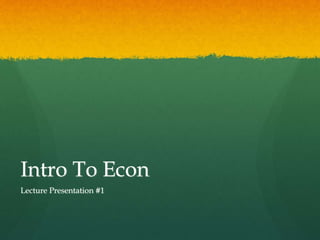
Intro to econ 2010
- 1. Intro To Econ Lecture Presentation #1
- 2. VOCABULARY Resources Production Wants Goods Services Scarcity Opportunity Benefits Costs Producers Labor Capital Consumers Macro- Economics Micro-Economics
- 3. What is Economics? Economics is the science that deals with the production, allocation, distribution and use of goods and services Put that into YOUR words
- 4. Micro and Macro Economics Micro= the “small” picture One specific event or business Study of individual decision- making Macro= the “big” picture The entire economy of businesses and choices Study of nationwide phenomena
- 5. The three basic questions of economics (WHFW) •What: •What goods and services should be produced? •How: •How should we produce these goods? How do we decide which method is best in producing our goods and services •For Whom: •Who will consume the goods and services that are produced? How will these goods and services be distributed among the different individuals in the economy
- 6. Scarcity and Choice The Facts of Life: -Resources are, and always will be, limited -The amount of goods an economy can produce is determined by how many resources are available at a given time -Given a set amount of available resources, an economy must decide how to cope with these limited resources.
- 7. Factors of Production RESOURCES: The land, labor, capital, and entrepreneurship used by society to produce consumer satisfying goods and services. Land Labor Capital Physical Human Entrepreneurship
- 8. RESOURCES: Land provides the basic raw materials-- vegetation, animals, minerals, fossil fuels-- that are inputs into the production of goods (natural resources). Labor is the resource that does the "hands on" work of transforming raw materials into goods.
- 9. Resources Continued •Capital: term for the vast array of tools, equipment, buildings, and vehicles used in production. •Also means $ (to buy this stuff) •Also includes the investment in the people involved •Spend $ to make $ •Entrepreneurship: taking the risk of bringing the other resources together and initiating the production process.
- 10. Goods & Services SERVICES: Activities that provide direct satisfaction of wants and needs without the production of tangible products or goods. (Doing stuff for others) GOODS: The physical, tangible products used to satisfy people's wants and needs (stuff you can touch)
- 11. Scarcity and Opportunity Costs In a world of scarcity, choosing one thing means giving up something else. The opportunity cost of a decision is the value of the good or service forgone. What did action or thing did you give up that you WOULD have done if you had the resources? Now YOU give an example of an opportunity cost
- 12. Supply The willingness and ability to sell a range of quantities of a good (stuff) at a range of prices, during a given time period. Things that effect supply? How much you have How hard it is to get How much you control How fast you can get it
- 13. Demand The amount of goods an individual, entity, or group will be ready, willing, and able to purchase at a given time at various prices.
- 14. Demand: How it is affected Variables that affect consumer demand: * The price of the product. * Consumer income. * Prices of related goods (substitutes and complements). * Consumer tastes and preferences * Expectations of future prices and availability. * Numbers and ages of buyers.
- 15. Needs vs Wants NEEDS: Those things which are required for survival in a given setting WANTS: The psychological desire which makes life just a little more enjoyable, but which is not physiological necessary to life.
- 16. Utility Utility = satisfaction HOW MUCH the item satisfies a want. When making choices, we tend to go for those things that give us the greatest UTILITY or satisfaction. May also think of it as “usefulness”
- 17. Production PRODUCTION: The process of transforming the natural resources of the land into consumer satisfying consumption and capital goods using scarce resources. i.e. – making natural “stuff” into usable, sellable “stuff”
- 18. Benefits and Costs BENEFIT: What you gain from doing something BENEFIT-COST RATIO: The benefit of an activity per dollar of cost. If benefits are greater than costs, then the project is worthwhile, if they are less, then it isn't.
- 19. Unintended Effects That which you did not count on when you made your choice Example: Paper tiles were $100 each I sold an average of 100 per day I made $10,000 per day WHAT IF I sold tiles at $200 each Shouldn’t I make $20,000?
- 20. Real Life Unintended Effects Govt wants to help small businesses. Many small businesses use trucks Contractors, Electricians, Landscapers, Delivery Vans etc Govt passes law that allows businesses to write off the cost of their trucks on their taxes Unintended Effect: Millions of people buy SUVs so they can write off the cost on their taxes Use more gas Less gas = higher price Also have more fatal accidents
- 21. Scarcity, choices, opp. costs People have wants. Because scarcity exists, people have to make choices. Because people have to make choices, they have opportunity costs The unintended effects of decisions can become part of the costs